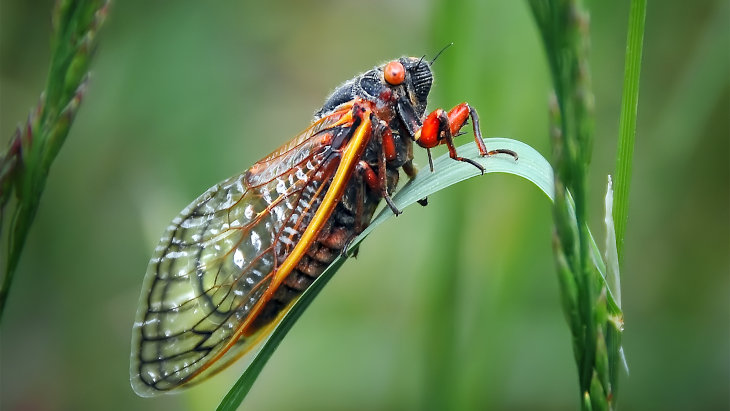 Vampire Weekend's Surprising Jewish Stories
Vampire Weekend's Surprising Jewish Stories


4 min read
Every 17 years trillions of cicadas emerge from the ground as a unified mass. They're on their way.
Even as you read these words, the frightful monsters are drawing nearer.
It won’t be long before many of us are facing huge red eyes, formidable wings and a collective roar, which, at 90 decibels, can be louder than an approaching subway train.
Yes, if the past is evidence, the 17-year cicadas will be returning to your neighborhood in late April or early May. At least if you live anywhere on the northern or central East Coast, or even as far west as Illinois or as far south as Georgia.
Readers in those areas who are under 20 years of age probably have no memory of the last appearance of “Brood X,” but those youngsters are in for a treat.
Literally trillions (and “literally” is used here, well, literally) of the large insects will emerge pretty much at once from the ground, where they have been biding their time for more than a decade and a half, living as nymphs of the species (Magicicada septendecim, if you really must know), nourishing themselves with the sap of the roots of the trees in which their long-gone mothers deposited them back in 2004.
They are intimidating creatures, both because of their size (a good two inches long with plus-size girths), broad orange stripes and those bright red eyes. But they are harmless to humans, other than those with a bug phobia, who may swoon when confronted by the supersize insects. They (the bugs, that is) tend to be clumsy flyers and often bump into unsuspecting people and other upright things.
Dogs and cats like to play with the defenseless cicadas (much to the latters’ chagrin), and birds consider them to be gourmet meals (even more disconcerting to the bugs).
For us humans, though, the invasion, which will last only a few weeks (but which may seem like months), should be a source not of amusement or nourishment, but of wonderment.

Of appreciation, that is, of the fact that for all modern science’s amassing of knowledge, even some prosaic things remain beyond its grasp. Because the cicadas’ mass unified appearance every 17 years remains one of nature’s great mysteries. “No one knows what mechanism they use to trigger their mass emergence,” says Michigan State University entomologist Howard Russell.
He explains further that the bugs are so sensitive they will even, in unison, postpone their emergence for a day or two if the temperature is right but the weather is rainy.
When science mavens speak of the unknowns, they tend to focus on things like the nature of time, the boundaries of space, the weirdness of quantum physics, the mystery of dark matter and black holes and other exotic creatures.
But there are countless mysteries all around us to which we may not give sufficient attention.
Like insects that somehow know when 17 years have passed and it’s time for them to emerge from the ground to lay eggs in twigs. Which will hatch weeks later, with tiny nymphs falling to the ground, burrowing in, and starting a new 17-year wait.
Truth be told, all of what we call nature is really miraculous, and our oblivion to the myriad miracles all around us is due only to our constant exposure to them. We become habituated to wonders and so don’t always rightfully wonder at them all. At least not until something we haven’t seen for a while—say, 17 years or so—suddenly makes an impression on us.
“If the stars should appear,” wrote philosopher and essayist Ralph Waldo Emerson, only “one night in a thousand years, how would men believe and adore; and preserve for many generations the remembrance of the city of God which had been shown! But every night come out these envoys of beauty and light the universe with their admonishing smile.”
Admonished we well should be if we don’t appreciate the wondrousness of the night sky or of everything else here on earth that we tend to take for granted.
And some red-eyed bugs, perhaps not quite “envoys of beauty” but striking in their own way, can remind us of all the equally astounding things that surround us always.

Yes, it gets us to think.
On a similar note, one of the great rabbis of several hundred years ago says that every day of the Nation of Israel's existence in exile, is a greater miracle than the Exodus from Egypt. So, if you ever wanted to get a video of it, just take a video of Jews today!!:)